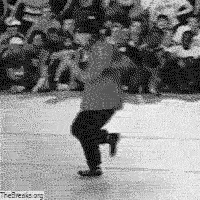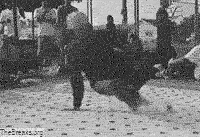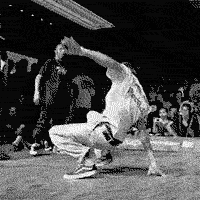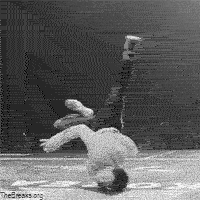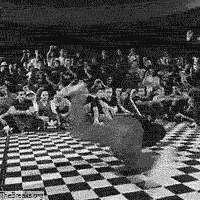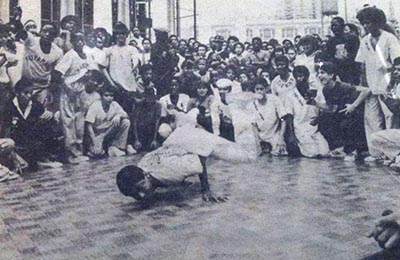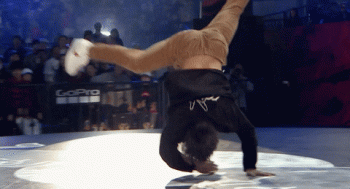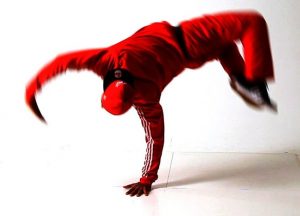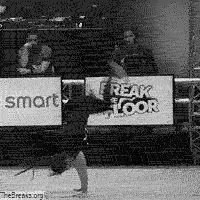Breakdance, or breaking, is a dynamic and athletic street dance that originated in the Bronx, New York, during the 1970s. It’s a vibrant art form that combines skill, creativity, and explosive power.
If you’re ready to dive into the world of this captivating dance, understanding the foundational breakdance moves is your first step.
This ultimate guide will introduce you to the core breakdancing moves, complete with their names and pictures, categorizing them into the essential elements that define this incredible dance. Whether you’re a complete beginner eager to learn breakdance moves or looking to refresh your knowledge of b-boy and b-girl moves, you’re in the right place to begin your journey.
Table of Contents
Basic Types of Breakdance Moves
Basic breakdance moves aren’t as showy as the more advanced ones, but if you’re going to move to the advanced moves, it’s important to master the basics. And if you choreograph well enough, these basic moves can still be turned into an exciting routine!
1. Top Rock
Top Rock is considered by many as the definitive “intro to breaking”. Instructors often use these as beginner breakdance moves to introduce newcomers to the sport.
It’s called by many names other than top rock. There are “uprock”, “tops”, “rocking on top”, and more. Whatever the case, you can glean the meaning of these moves just by reading its name: simply dancing while standing upright.
Top Rock is often used to signal the style of the dancer at the beginning of the performance. For this reason, many professional dancers put in a lot of effort to develop their top rock. A good top rock is considered a point of pride.
It is also used as a warm-up transition for more advanced moves, like Downrock.
There are many different Top Rock techniques that you can use to ornate your routine. Here are a few foundational and easiest ones.
Indian Step
The Indian Step is a top rock pattern that was developed by two legendary breakers, Pow Wow and Sundance. At first, they called it “Cross Overs”. Eventually, the name evolved into “Indian Step”. It’s also known under other names, like the “Outlaw Step” and the “Front Step”.
It is relatively simple, involving crossing your legs in front of the other. Most beginner breakers will be able to get used to the pattern in a day or two.
Hip Twist
The Hip Twist is the Indian step with a literal added twist. You still rock on top with your legs crossing one another. But the thing that separates this technique from the standard Indian Step is that there’s an extra hip twisting motion.
Aside from being known as the “Hip Twist”, it’s also known as the “crossover Indian step” and the “original Indian step”.
Side Step
The Side Step is a top rock pattern consisting of a kicking motion with a one-side step. As the move has been said to take roots from salsa, the Side Step is also called the “Salsa Rock” or the “Latin Rock”.
Bronx Step
The Bronx Step involves taking a step diagonally forward. Then, with your other foot, slide diagonally backward. The result should look like you’re marching very jazzily in place.
Similar to other steps, the Bronx Step also has had many different names over the years. It’s also known as the “March Step” or the “Sailor Step”.
Kick Step
To do a Kick Step, kick one leg forward, then immediately make a step back when the foot touches the ground. Alternate to the other foot, and you have one complete pattern.
The Kick Step has a history dating back to 1984 with Lil Boy Keith.
2. Footwork
Footwork is one of the most iconic parts of breakdancing. So much so that many have called it the heart of breakdancing. When you think of a breaking routine, you’ll probably think of dancers breaking out intricate movements on the floor.
These moves are often done near the floor. The breaker would support their body with their hands, while their legs perform the magic.
The idea of doing footwork may sound intimidating to beginners. In actuality, there are many basic moves that you can comfortably pull after only a few days of diligent practice.
Helicopter (FW)
A signature move of many breakers, the Helicopter involves sweeping a full circle with one leg while squatting. A small jump is usually done over the sweeping leg.
This move began to become popular sometime in the 60s and early 70s. Because of its unique aesthetic, there are many sources that claim the Helicopter took inspiration from old kung-fu, martial art movies.
The Helicopter is also known as the “Front Sweep”, the “Coffee Grinder”, and the “One Step”.
2 Step
You can identify a 2 Step by counting the movements in the sequence. Usually, it involves a half-turn sweep (1st step) and then a return sweep to a squatting position (2nd step).
The technique was invented by Lil Julio in the 70s and evolved from the basic Helicopter. As such, we highly recommend mastering the Helicopter before moving on to this technique.
The 2 Step is also known as the “Baby Swipe”.
3 Step
For the most part, a Three Step is exactly like a Two Step, but has an extra sweep added. Because of this, a Three Step will usually look a bit slower and more controlled than the frenetic energy displayed by a Two Step.
Similar to the 2 Step, the 3 Step first appeared on the breaking scene during the 70s. The credit for the move went to Batch.
6 Step
A 6 Step is a series of small sweeps revolving around one supporting arm. You will use both arms during a sequence, changing the supporting arm every half-circle.
The 6 Step was credited to Shorty Rock in the 70s.
12 Step (Scramble)
The 12 Step (also known as the “Scramble”) involves revolving in a circle with both legs stepping over and under the other. The hip is going to twist back and forth in the process.
As it took inspiration from salsa, the 12 Step is also referred to as “Floor Salsa”.
Lego Leg
In the Lego Leg, a leg is swept in-ward and hooked around the back of the other leg’s knee. One arm is kept behind the breaker’s back to support the movement.
This technique was developed by Lego (the breaker, not the toy company) in 1994. It’s an evolution of the popular move – “Blender”.
Blender
To do the Blender, simply perform a series of inside sweeps with your legs while shifting your weight back and forth between your two arms. If you’re familiar with gymnastics, this move looks a lot like the “Scissor” move.
The Blender became popular around the mid-80s after a performance by the London All Stars. One member could be seen doing the Blender on stage.
Knee Rock
Knee Rock is spinning your upper body with either one or both knees touching the ground. The supporting arm is alternated as you spin.
After Wizard Wiz added knee-rocking into his routine in the 70s, the move was picked up by the community.
Shuffle
The basic Shuffle is done with both arms on the ground. The legs drag and rapidly switch places with one another at the back. Due to the rather basic nature of the Shuffle, there have been many variations done by many B-Boys and B-Girls since the 70s.
Sweep
The main principle of the Sweep is rather simple: one leg makes a horizontal sweep in a wide circle.
This move began to show up in the breaking community sometime in the mid-70s. Some sources say that it showed up and became popular around the same time as the Helicopter. Additionally, like the Helicopter, the Sweep is said to have been inspired by old kung-fu movies.
3. Power Moves
The most taxing moves in breakdancing are called Power Moves. They’re often used not only because they’re extremely eye-catching, but also because they showcase the strength of the breaker.
Power moves are some of the more difficult techniques. You’ll need proper technique as well as strength conditioning to pull them off beautifully and safely. So, make sure that you cover all of the basic skills in break-dancing before you move onto this category.
Windmill
In a Windmill, the breaker drops down onto the floor and rolls around using its upper back, shoulders, and arms. The legs are extended upward and swing around in a circle.
The “discovery” of the Windmill was an accident. Officially, the technique was credited to Crazy Legs. During a performance in 1978, he accidentally over-rotated a chair spin from a backspin, resulting in the form that is now known as the Windmill.
Shoulder Spin
The Shoulder Spin evolves from the Back Spin. It is basically a variant of the one-arm shoulder freeze, where the breaker erects themselves upside down with the weight of the body wholly supported by one shoulder.
Just add a spin to the freeze and you go the Shoulder Spin!
Headspin
The Head Spin is a spinning headstand. This is an absolutely classic move and has appeared in many break-dancing movies, documentaries, and shows. It became popular sometime in the 70s and was probably influenced by kung-fu movies.
Floats
Supported by just one arm, the breaker horizontally spins their entire body around. That is the Floats. It takes a great deal of power to pull off. Technical know-how is also needed as it’s very easy to get a wrist injury while exercising the move.
- Man developed and popularized the move in 1979.
Flare
Yet another classic break-dancing move. In the Flare, the breaker swings their legs and lower body around in a circle while supporting their body on one arm.
It entered the breaking scene in the mid-70s. The earliest record of this move was during a performance of Trac 2.
The Flare is also known as “Thomas Flair” after Kurt Thomas, who developed a skill in gymnastics that ultimately inspired the Flare in breaking.
Head Glide
Unlike the Head Spin, the head only touches the ground in the Head Glide. One hand is responsible for supporting the body and acts as the foundation for the spinning motion.
The Head Spin is also known as the “Icey Ice” or the “Chair Glide”.
Hand Glide
In order to execute the Hand Glide, you must be familiar with the Turtle Freeze. The Hand Glide is basically a spinning, one-handed variant of the Turtle Freeze.
1990
The 1990 (or “90” and “handspin”) is done by doing a one-handed handstand, then putting a spin to your entire body. Support for the body and the rotating motion is all done by one hand.
1990 was developed by Trac 2 in the late 70s. Many records indicated that Trac 2 might have taken some inspiration from techniques in gymnastics, like the Pommel Horse Dismount and the Handstand Pirouette.
Halo
The Halo is a pattern that starts with a supported head spin, then ends in a position that resembles the baby freeze. The rolling motion of the head looks like the shape of a halo, hence the name.
Icey Ice was credited for being the first to serve up the move in 1983.
Critical
From a Turtle Freeze, the breaker pushes their entire body off the ground in a rotating hop. That’s the foundation of the Critical.
This technique is also known as the “Turtle Flip” and the “Def Air”.
Cricket
The Cricket resembles the Critical in that it starts with a Turtle Freeze (or alternatively, a Hand Glide). Then, it transitions to a rotating hop. Basic Cricket uses two hands to support the body’s weight. Some variations of the technique use only one hand.
4. Freezes
Freezes are moves where the breaker strikes a pose with their body and holds it for several seconds. In a performance, freezes can be used to highlight an exciting section in the music. These breakdancing poses can also be used to end a series of movements or patterns.
Airbaby
In the Airbaby, the breaker does a handstand supported by both arms. The freeze comes into shape when one knee rests on the elbow of the corresponding side of the body.
Airchair
One arm supports the entire body in the Airchair. In the correct position, the elbow of the support arm should touch and support the lower back and hips of the breaker – both of which should be facing upward.
Baby
There are three points of contact in the Baby Freeze: the side of the head and two arms. The elbow on one side of the body should make contact with the side of the breaker’s waist as they lock into position.
Shoulder Freeze
We’ve mentioned this freeze briefly before. It is the prerequisite technique that you need to learn before you can nail the Shoulder Spin. In the Shoulder Freeze, the body’s weight is supported entirely by one shoulder.
Bridge
Bridge is a rather simple freeze compared to others, but it requires a degree of flexibility to pull off well. In the Bridge, the chest faces upward while being supported by two arms and legs bending backward, resembling a bridge.
Chair
There are three points of contact in total in the Chair Freeze: the leg, the arm, and the side of the head. The elbow of the arm that you use to support your body should make contact with the side of your waist.
Elbow Freeze
In the Elbow Freeze (or the “Forearm Freeze”), the body is supported by the breaker’s forearm and elbow.
Hand Stand
Not much has to be said about the Hand Stand. The breaker inverts their body and maintains a vertical pose, supported by both hands. To have better balance and to have a bit more flair, most breakers will usually spread their legs to either side in a V-shape.
Halo Freeze
The Halo Freeze – also known as the “Hong 10 Freeze” after the legendary B-Boy Hong 10 – involves supporting your body with both arms and the backside of the head. The elbow of one arm makes contact with the lower back. Lastly, the legs should be swept horizontally to one side.
This freeze is notorious for its strength requirement. It takes a lot of muscle power to hold it for a long time. As such, it’s seen as a test for a great many B-Boys and B-Girls looking to test their limits.
Turtle Freeze
In the Turtle Freeze, both arms support the body and dig into the abdomen. Legs are bent at an angle behind the breaker.
5. Go Downs (Drop)
From top rocking, the breaker can transition their body down to the floor by “going down” (or “dropping”). The objective is to transition away from top rock as smoothly as possible to the tune of the music.
Knee Drop (AKA Pin Drop/Colt-45)

In the Knee Drop, the performing B-Boy or B-Girl will perform a back knee hook (hooking one foot around the back of the other leg’s knee). Then, they will drop down to the floor onto the hooked knee and foot.
Other than serving the purpose of bringing the body close to the ground, it also makes for a pretty sweet illusion of landing on top of the knee.
Spin Down (Corkscrew)
This is a pretty advanced drop. In it, the breakers jump high into the air and perform at least two rotations sideways before landing back onto their feet close to the ground.
Sweep Drop
Sweep your leg in front of the other as you advance forward. Practice in the mirror. It should look like you just accidentally tripped over your feet.
Walk Through
Lean forward and transition into a crouch, catching your momentum with either one or both arms. Move your foot forward between the arms and the other opposite foot.
This move is also known as “Walk In”.
Blender Drop
This advanced drop makes use of two techniques: the Walk Through above and the Blender footwork move. Starts with a walkthrough, then transitions straight to a Blender.
Bellyroll Drop
Drop your body and transition to a roll supported by your front chest. Typically, the Bellyroll Drop is used to transition to a Back Sweep. This is known as the Korean Sweep.
6. Transitions
Transitions are the moves that allow the breaker to seamlessly switch between different moves in their routine. It can also be used to combine different footwork steps, moves, and tricks with the express purpose of making them look better.
When a transition is executed well, the audience shouldn’t be able to notice it at all before the next move is already underway. It should be seamless and fluent.
7. Tricks
Tricks are where different B-Boys and B-Girls show their skill, personality, and their creativity. A move is called a “trick” when the breaker takes a conventional breaking method and adds an unusual twist to it.
8. Flips
Breakdancing takes a lot of inspiration from gymnastics, which is why you’ll often see breakers somersaulting and flipping all over the stage as they go through their performance. It’s rare to see a pro-level breaking performance without a flip or two added in.
Check more: Best Break Dance Movies: List Of Top 8
Some Advanced Breakdance Moves
Many of the techniques we showed you earlier are touching the intermediate-advanced lines. However, if you’re truly looking to test yourself or to set a goal, the following breakdancing moves are some of the most difficult that a B-Boy or B-Girl could ever hope to perform.
Jackhammers
Jackhammers is considered a variant of the Cricket. This move is marked by the fast-pace hopping done on just one supporting arm. The other arm is usually set at the breaker’s back to showcase the degree of control they have over their body.
The current world record for the most Jackhammers achieved in a single session is 113 by B-Boy RYUTA.
Taisuke Criticals
This move is named after Taisuke – a renowned breaker, who’s famous for the speed and fluency of his movements. It is a variant of the Critical. However, the way Taisuke does it, the spin-hopping motion looks like it lacks momentum, yet he’s able to throw his body high up into the air.
Takes a lot of strength and skill to pull off this one right!
Head Slide
Get a running start, drop down to your knees, and immediately transition to a headstand. That’s the head slide. It may sound simple, but it’s actually extremely difficult to pull off … without being seriously injured. A lot of weight is placed on the head and the muscles in the neck.
Elbow Spin
In the Elbow Spin, the breaker’s body weight is supported by their forearm and elbow in a classic Elbow Freeze. Add a spin to it and you get an Elbow Spin.
Air Flare
It is a variation of the classic Flare. In the Air Flare, you need to keep your body entirely inverted and vertical, with your hips high off the ground. Then, you have to spin in a circle while “hopping” with your hand. Every time you transition your hand, your entire body must be completely off the ground.
It’s a very difficult move that requires a lot of upper body, arms, and core strength.
1.5 Air Flares
The 1.5 Air Flares is a more dangerous and exciting twist to the standard Flare and Air Flare. Start with a classic Flare, then gain momentum and push your body off the ground. In the process, do a 180° turn and land on your shoulder (rather than your hand).
It’s very easy to suffer from a shoulder injury while practicing this trick. So, if you want to try, lay a lot of padding on the ground first.
One-Handed Air Flare
Last but not least, we got the One-Handed Air Flare. The technique is the same as a standard Air Flare but this time, you can’t use your other arm. You got one supporting arm and you got to commit to that throughout the entire move.
If you think Air Flare is hard, this one is harder by orders of magnitude. It’s harder to maintain balance and it’s a lot easier to suffer from an injury. Only the most experienced break-dancers would dare to attempt this trick.
Safety First: Essential Warm-up & Injury Prevention
Before attempting any breakdancing moves, especially power moves, proper preparation is crucial to prevent injuries.
Always start with a thorough warm-up, including light cardio and dynamic stretches. Focus on warming up your wrists, shoulders, neck, and core. Static stretching should be done after your session.
Common breakdance injuries include wrist sprains, shoulder impingement, and knee issues. Strengthening exercises for your core, wrists, and shoulders will build the necessary support.
Always practice on a safe, smooth surface, and consider investing in wrist guards or a headspin beanie for specific moves. Never push beyond your current physical limits; incremental progress is key.
FAQs
1. How Did Breakdancing Begin?
Breakdancing became a thing in the late 60s and earlier 70s. Most sources attributed its point of origin to New York City. Particularly, the Bronx area of NYC is famed for being the home of hip hop culture.
Though it’s really been around for decades prior, breakdancing only truly picked up in the 80s when pop artists began to show interest in this exciting form of dance.
2. What Are the Most Common Moves in Breakdancing?
Though you’ve read plenty of B-Boying moves and tricks, a common break-dancing routine only consists of four things: top rock, down rock, power moves, and freezes.
3. What Is the Hardest Break Dance Move?
That’s easily the One-Handed Air Flare. Achieving a good Flare is already a pretty big milestone in the career of a B-Boy or B-Girl. Doing an Air Flare is even more so due to its sheer difficulty.
But having to spin around on just one supporting arm – beautifully and more importantly, safely – is a thing that only the best breakers can do.
Make Your Move!
This list is definitely not all-inclusive. There are hundreds of different breakdance moves that you can learn to make your routine more exciting and beautiful. With enough practice, you may even be able to invent your own signature moves!



